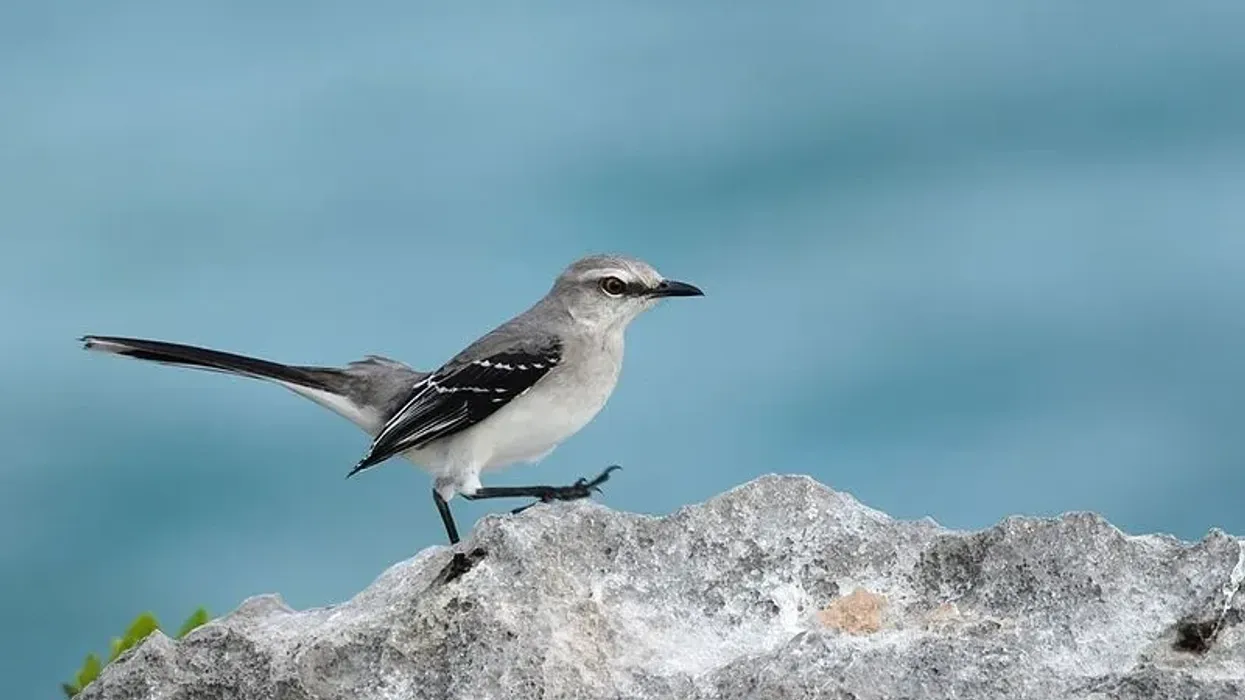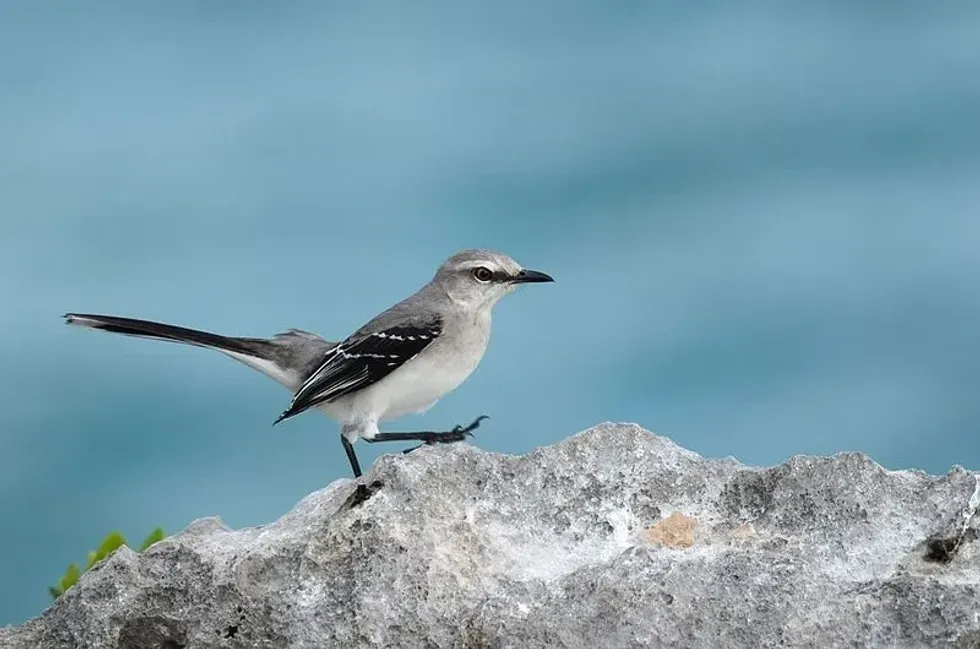Did you hear birds singing musically all through the night? Sounds exciting? This is the tropical mockingbird, Mimus gilvus. It belongs to the family of mockingbirds, Mimidae, and genus Mimus.
Mocking birds are known for their singing skills. They mimic the sounds of other amphibians, insects, etc., in quick succession and loudly. Also called the southern mockingbird, it has a huskier voice than the northern mockingbird (M. polyglottos), its close cousin. The Socorro mockingbird (M.graysoni) is also close to these birds.
The tropical mocking birds are gray on their upperparts, head, and they are off-white on underparts. They have a white eye stripe and yellow eyes, with a dark color patch running through the eye.
The wings are blackish with two distinct wing bars and white edges on flight feathers. Their tail is long, dark with white feather tips, a small bill with a downward curve, and their legs are dark and long.
The younger birds look browner but duller. This species from Trinidad and Tobago regions has darker gray upperparts and whiter underparts, wing coverts, and tails than mainland forms.
You can also explore other exciting birds like blue jay and toco toucan in our other articles.
Tropical Mockingbird Interesting Facts
What type of animal is a tropical mockingbird?
The tropical mockingbird, Mimus gilvus, is a bird of the Mimidae family. The mockingbird got this name because of its ability to mimic the calls of other bird species. There are 17 subspecies of mockingbirds found across Mexico, Brazil, and many other places.
What class of animal does a tropical mockingbird belong to?
The tropical mockingbird belongs to class Aves and genus Mimus. Its close cousins are the Northern mockingbird (M. polyglottos) and Socorro mockingbird (M. graysoni).
How many tropical mockingbirds are there in the world?
The population size of tropical mockingbirds is estimated to be between 500,000 to 5 million. Therefore, it is not an endangered species. Moreover, this species has an extensive range, and its population trend seems to be increasing. They are found across United States, Mexico, and Brazil.
Where does a tropical mockingbird live?
Tropical mocking birds are breeding residents of southern Mexico, Brazil, Caribbean islands, lesser Antilles. It is also found in some parts of Central America. A few species of this bird are also found in Trinidad and Tobago regions.
What is a tropical mockingbird's habitat?
They are found in most open and semi-open tropical lands, human habitats, etc. They also come down to the ground, or vegetated areas, to forage on invertebrates.
Who do tropical mockingbirds live with?
It is not known that the tropical mockingbird lives in groups. However, in general, the mockingbird lives a solitary life except during the mating season. A subspecies of mockingbirds, Galapagos mockingbirds, live in communities of up to 24 individuals.
How long does a tropical mockingbird live?
Though not much is known about the exact life span of the Southern mockingbird, its close cousin, the Northern mockingbird, lives for about eight years in the wild. However, it can live up to 20 years in captivity.
How do they reproduce?
The male mockingbird, known for its singing, sings different songs (as many as 200 songs!) to attract the female for mating.
It would be interesting to note that an unpaired mockingbird sings all through the night, displaying its impressive vocal range, to attract a female for breeding, at the risk of predation. Thus, the song is a vital part of mating. Scientists have also discovered that male singing resets the reproductive system of females.
The female clutch is, usually, three grayish-green eggs in a twig nest. The incubation period is about 13 to 15 days, which is done by the female only. After that, parenting is done by both males and females. They both defend the nest and eggs aggressively attack predators such as other birds and animals like dogs and iguanas.
The male eventually takes overfeeding and teaches the nestlings to fly while the female works on other nests and brooding.
What is their conservation status?
The tropical mockingbird's conservation status is of Least Concern according to the IUCN, as they are prolific breeders and their population size appears to be increasing.
Tropical Mockingbird Fun Facts
What do tropical mockingbirds look like?

The tropical mocking birds are gray on the head and upperparts. These birds have yellow eyes, a white eye stripe with a dark color patch running through the eye.
The underparts are off-white. The wings are blackish with two distinct wing bars and white edges on flight feathers, and a dark tail. The tail is long with white feather tips, a black bill with a slight downward curve, and dark, long legs.
Both sexes look similar, and the juvenile birds look browner but duller. This species from Trinidad and Tobago regions has darker gray upperparts and whiter underparts, wing coverts, and tails than mainland forms.
It is interesting to see that they spread their wings to flash the white wing linings and fold them again while they forage.
How cute are they?
Their look is cute, though not very colorful. Their singing abilities and fearless intrusion into the human habitat to steal food from plates connects us to them and makes them adorable.
How do they communicate?
Singing is an essential mode of communication for mockingbirds, serving two essential purposes, mating and protecting their territory. The male singing is heightened during the spring breeding season. The female prefers the male, who sings more songs, which indicates established territory and experience. The females sing during autumn and less during the breeding season.
Interestingly, the Northern mockingbird has four types of calls: the nest relief calls, chats or chat bursts, hew calls, and the begging calls. The most important is the hew call used for nest predators and a variety of interactions between mates.
The Cornell Lab of Ornithology tracks the birds with badges and keeps a record of their calls too.
How big is a tropical mockingbird?
The length of Mimus gilvus is about 9.8 in (25 cm). This bird could be slightly larger than a gray catbird and somewhat similar to a robin. The Northern mockingbird may be slightly larger than the tropical mockingbird Mimus gilvus.
How fast can a tropical mockingbird fly?
The Mimus gilvus is not known for its flight speed, but it quickly flies down from the perched tree to the ground for forage. The nestlings start flying from about 15 days after they are hatched.
How much does a tropical mockingbird weigh?
A Mimus gilvus weighs about 1.2 lb (54 gm). The female is smaller than the male.
What are the male and female names of the species?
The male is called a male tropical mockingbird, and the female is called a female tropical mockingbird.
What would you call a baby tropical mockingbird?
The babies are referred to as nestlings as soon as they are hatched.
What do they eat?
The diet of a Mimus gilvus consists of insects like beetles, and love fruits like berries. When they forage, they display a peculiar two-step motion to spread their wings. It is interesting to see that they flash the white wing linings and fold them again.
Are they poisonous?
Though not much is specifically know about the tropical mockingbird, Mimus gilvus, the mockingbird is not poisonous. But the Northern mockingbird is highly territorial and recognizes anyone who disturbs their nests or eggs even after as little as two instances.
They attack or kill other birds like crows, hawks, and animals like cats or dogs, but tend to leave human beings alone.
Would they make a good pet?
Tropical mockingbirds (Mimus gilvus) do not make good pets or cage birds because they do not survive well in a household setting. In addition, it is illegal in the United States to capture them.
Having them visit the backyard frequently by planting fruit trees may be a better option.
Did you know...
Tropical mockingbirds (Mimus gilvus) are aggressive when they are in an environment where the lead content in the soil is high. They become even more territorial in such a habitat.
Five states in the United States have declared the mockingbird as their state bird, and it also appears in songs, book titles, lullabies, and more.
What is special about tropical mockingbirds?
The tropical mockingbird has a huskier voice than the northern mockingbird and generally imitates other tropical mockingbirds.
Where do mockingbirds get their name?
They are called mockingbirds because they are, by far, the most skilled at mimicking birds. They can copy frogs, toads, dog barks, and even machine sounds! The northern mockingbird is called Mimus polyglottos, meaning many-tongued mimic.
Here at Kidadl, we have carefully created lots of interesting family-friendly animal facts for everyone to discover! For more relatable content, check out fox sparrow facts and red-eyed vireo facts.
You can even occupy yourself at home by coloring in one of our free printable Tropical mockingbird coloring pages.









